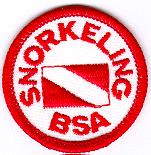SWIM TRUNKS EMBLEM
The Snorkeling, BSA Patch is NOT worn on the Uniform.
It is worn on the left side of the swim trunks.
- Before doing other requirements, successfully complete the BSA swimmer test. Jump feetfirst into water over the head in depth, level off, and begin swimming. Swim 75 yards in a strong manner using one or more of the following strokes: sidestroke, breaststroke, trudgen, or crawl; then swim 25 yards using an easy, resting backstroke. The 100 yards must be completed in one swim without stops and must include at least one sharp turn. After completing the swim, rest by floating.
- Discuss the importance of using the buddy system at all times while snorkeling and list duties of a buddy, beginning with equipment checks.
- Explain the function, fit, and selection of mask, fins, and snorkel. Discuss the use of inflatable flotation vests and life jackets when snorkeling in open water.
- In confined, shallow water (about waist deep), demonstrate use of mask
and snorkel:
- Show how to prevent the mask from fogging and how to equalize pressure in mask, ears, and sinus cavities. With your head underwater, flood the mask, observe the effect on your vision, surface, and drain the water from the mask.
- With your face in the water, breathe through the snorkel. Then submerge, surface, clear water from the snorkel, and resume free breathing without removing the snorkel from your mouth.
- In confined, shallow water, demonstrate the use of swim fins: Do first
using only fins, and then repeat with a mask and snorkel.
- Fit and adjust fins to feet.
- Walk with fins as if entering from a beach.
- Swim at the surface (10 yards) and underwater (three yards) using the flutter kick.
- Control direction without using hands while swimming with fins at the surface and underwater.
- In confined, deep water (six to 12 feet), demonstrate:
- Proper techniques for entering and exiting the water with snorkeling equipment from a dock or boat.
- Headfirst and feetfirst surface dives, including proper body position for safe ascent and descent.
- Show knowledge of snorkeling signals:
- Demonstrate divers’ signs and signals, both audible and visual, for use at the surface and underwater.
- Set out a diver down flag and explain its function.
- In clear, confined water eight to 12 feet deep that has a firm bottom, while swimming with a buddy, use mask, fins, and snorkel to locate and recover an object from the bottom.
- Demonstrate basic survival skills:
- Float facedown for five minutes while breathing through a snorkel with a minimum of movement.
- Demonstrate survival floating for five minutes without use of a snorkel.
- Using fins, show how to tow an exhausted or unconscious buddy to safety.
- Review and explain the eight points of Safe Swim Defense and BSA Snorkeling Safety. Explain training, preparations, and precautions required for snorkeling in open water. Explain environmental factors that affect snorkeling and discuss special precautions needed for oceans, streams, and lakes.
- Explain pressure, buoyancy, and submerged optics and acoustics
related to snorkel swimming and diving. - Discuss the effects of submersion on the body and how to handle potentially
dangerous situations:
- What is hyperventilation and how is it avoided?
- What are the symptoms and consequences of hypothermia?
- Why is CPR training recommended for those participating in swimming and snorkeling activities?
The eight points of BSA Snorkeling Safety are:
- Qualified Supervision
- Physical Fitness
- Safe Area
- Proper Equipment
- Qualified Lifeguards / Lookout
- Ability
- Buddy System
- Discipline
Note to Counselors:
Purpose: The Snorkeling BSA requirements introduce Scout-age children and adult leaders to the special skills, equipment, and safety precautions associated with snorkeling; encourage the development of aquatics skills that promote fitness and recreation; and provide a foundation for those who later will participate in more advanced underwater activity.
Counselors: Any adult trained and assigned by a currently certified BSA Aquatics Instructor may serve as a counselor for the Snorkeling BSA award. A person certified to conduct snorkeling instruction by the Professional Association of Diving Instructors (PADI), or the National Association of Underwater Instructors (NAUI), or other BSA recognized agency also qualifies as a Snorkeling BSA counselor.
Recognition: The individual completing the official requirements qualifies for a recognition card and swimsuit patch. The completed award application should be submitted to the local council service center by the counselor or unit leader.
Programming: Instruction must be conducted in clear, confined water with a maximum depth of 12 feet. A swimming pool is recommended. Snorkeling BSA is ideally suited to winter programs using indoor pools. Three 45-minute sessions are recommended for instruction, practice, and completion of requirements.
References: The Swimming merit badge pamphlet provides reference material for Snorkeling BSA. NAUI, PADI, equipment manufacturers, and others publish references available through bookstores and dive shops. The PADI snorkeler’s field guide, Discover the Underwater World, is one such resource. Although few dedicated snorkeling texts are available, instruction manuals for scuba diving contain pertinent information.
Requirements: All requirements must be completed as stated on the application form. The counselor may not omit, vary, or add requirements. The skill requirements are presented in the order in which they should be taught to the Scout.
The second requirement considers the time-honored and time-proven principle of the buddy system. Snorkelers must use the buddy system at all times. Before beginning the activity, each person helps his buddy fit and check equipment. The principle of the buddy system is that two people can enjoy an aquatics activity together while each provides a critical margin of safety for the other. Each buddy must constantly be aware of the condition and circumstances of his buddy, and must always be prepared to call for aid or give immediate assistance if needed.
Source: BSA Publication No. 430-603.
Source: SCOUTS BSA REQUIREMENTS 2022 (SKU 656269)








